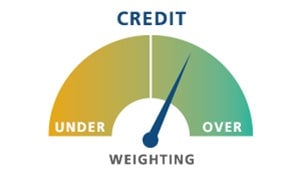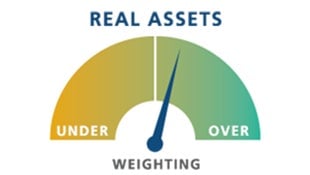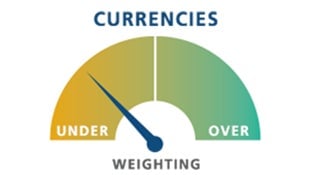Without a falling-rate tailwind, investors will need to choose the right risks
Let’s start with restating the essential point: The tailwind to asset classes from ever-lower interest rates is largely behind us. Over the past several years, lower risk-free rates from aggressive central bank policies accompanied by dropping inflation created a “denominator effect” by pushing discount rates lower, which in turn led to higher valuations of assets. The discount rate applicable to future cash flows, regardless of the asset class, starts with the real “risk-free rate.”


Let’s start with restating the essential point: The tailwind to asset classes from ever-lower interest rates is largely behind us. Over the past several years, lower risk-free rates from aggressive central bank policies accompanied by dropping inflation created a “denominator effect” by pushing discount rates lower, which in turn led to higher valuations of assets. The discount rate applicable to future cash flows, regardless of the asset class, starts with the real “risk-free rate.”
The appropriate discount rate for each asset class can be modeled as the risk-free rate with an additional risk premium associated with its position in the capital structure and exposures to risk factors: for example, inflation and term premia for sovereign bonds, default and liquidity premia for credit, and equity risk premium for equities—each building off the risk-free discount rate. As risk-free rates drifted lower over a period of many decades, not only did the present value of future cash flows increase in the sovereign bond market, valuations increased broadly across all asset classes as growth expectations declined by less than the drop in risk-free rates.

So where are we headed? In fixed income, we do not see significantly higher bond yields over the next three to five years. Rather, policy rates are expected to rise gradually over the secular horizon. This change, from steadily falling discount rates to stable or, in many cases, modestly rising discount rates, will likely have substantial consequences: first, via lower expected returns, and second, on portfolio construction.
In this new regime, rigid “buy-and-hold” strategies may not work as well as they did in the past. A prime example is the recently popularized “risk parity” approach to asset allocation, a strategy by which portfolio allocations are sized in order to ensure the risk contribution from stocks, bonds and inflation-related assets is equal, or at parity. Given bonds generally have lower volatility than stocks and other assets, risk parity strategies systematically use leverage to increase risk exposure to the bond component. Over the past several years, markets have been generally friendly to these strategies as bond term premia compressed and volatility became subdued. However, they may now face headwinds as volatility resets and interest rate trends reverse, necessitating an active approach when managing these strategies. Moreover, studies have shown that the negative correlation between stocks and bonds (one of the key tenets behind this approach) tends to be greater when yields are falling than when yields are rising, which has significant implications for portfolio construction and diversification.
It seems clear that in the market environment we are facing, tactical asset allocation and robust portfolio construction will become even more important as correlations become increasingly unstable and dispersion increases across asset class returns. In this new regime, region, country and sector selection and bottom-up relative value strategies will have to do more of the heavy lifting to help offset either the end or reversal of the tailwind of declining discount rates.
Overweight the right risks
Despite the waning tailwind of declining discount rates on asset class returns, we believe investors should not only stay invested, but look for opportunities to strategically overweight risk positions over the long term. Moderate global growth and a gradual upward path to interest rate levels lower than in previous cycles should be supportive of asset classes, though support is more tilted to providing a floor than providing a boost.
Equities

- A global survey of equity risk premia suggests fair to attractive valuations relative to bonds and recent history
- Exposure in Europe and Japan appear attractive given policy efforts that are stimulating growth, the levels of dividend yields and current valuations
- Emerging markets, particularly those in Asia, offer attractive opportunities for strategic overweights given macro trends, supportive policy and reforms, and levels of equity risk premia particularly when compared to recent history
Rates

- Core fixed income retains its important role in a multi-asset portfolio to provide diversification and income
- We are wary of exposure to interest rates in developed markets as rates are low and poised to rise
- There are interesting opportunities in select EM countries, including Mexico and Brazil
Credit

- Despite low all-in yields across credit sectors, spreads above government rates remain within fair to attractive levels
- We find specific opportunities such as European financials and U.S. housing-related credits most attractive
- A deeper appreciation for potential liquidity is needed given less inventory capacity at banks due to global banking regulations
Real assets

- Global inflationary trends may be poised to reverse and gain positive momentum, bolstering the case for real assets
- Inflation-linked bonds are particularly attractive as their prices continue to imply very low inflation premia when compared with nominal bonds
- Differentiation and tactical agility will be necessary to extract attractive returns from commodities as we believe supply and demand are generally matched
Currencies

- We remain bullish on the U.S. dollar, and thus underweight international and emerging market currencies, given the divergence of Fed policy with most global central banks
- There are select opportunities in higher-yielding EM currencies like the Indian rupee; investors should nevertheless be wary of the potential for heightened volatility
Find PIMCO’s full Asset Allocation Secular Outlook here. For more, read PIMCO’s key global market trends to watch.
This article was written by PIMCO and not by the Quartz editorial staff. All investments contain risk. This site contains information provided by both PIMCO and Quartz. PIMCO content contains the views and opinions of PIMCO and/or its representatives at the time of publication. This information is provided for illustrative purposes only and is subject to change without notice. This material is not indicative of the past or future performance of any PIMCO product and should not be considered as investment advice or a recommendation by PIMCO of any particular security, strategy or investment product. PIMCO is not responsible for the information or views communicated by the Quartz or any other non-PIMCO content.